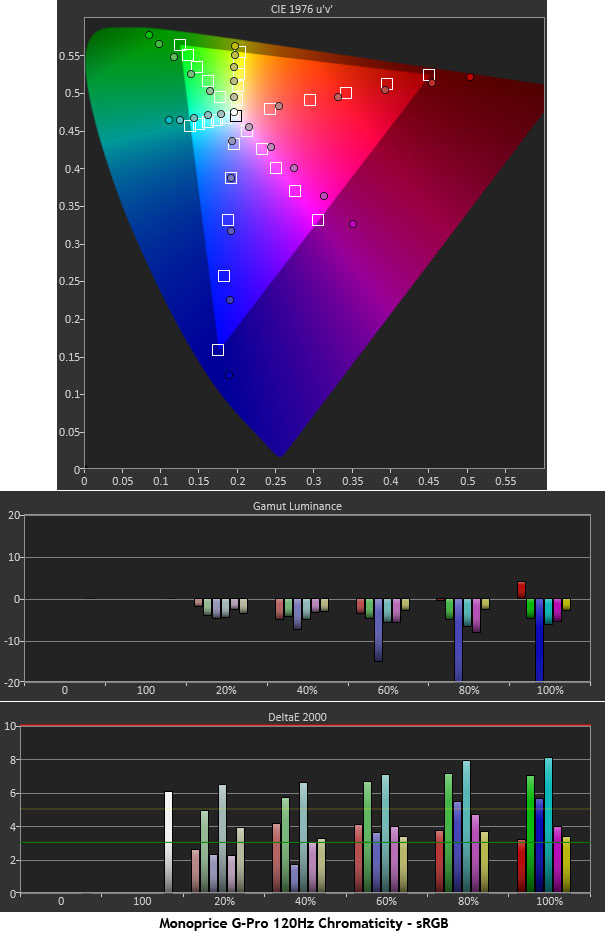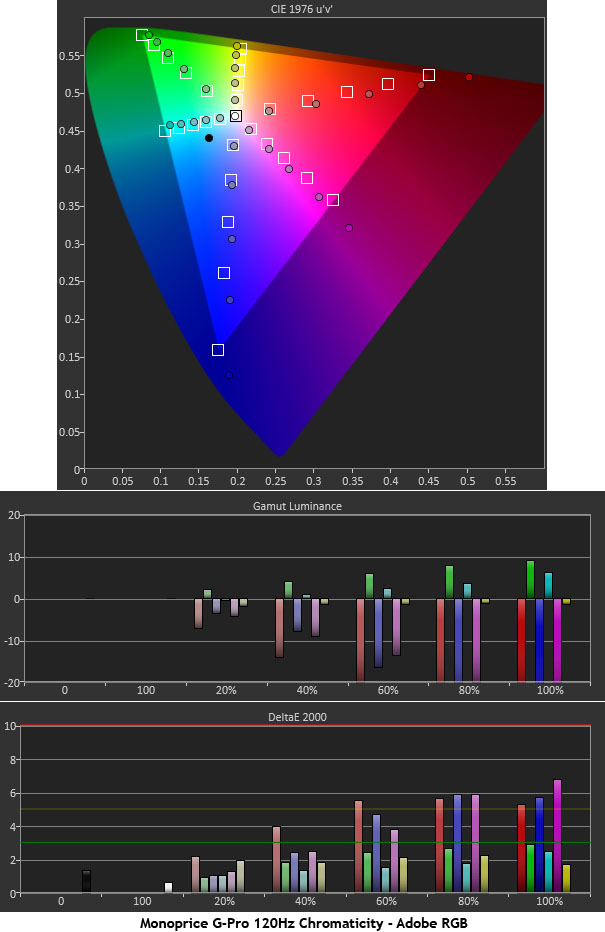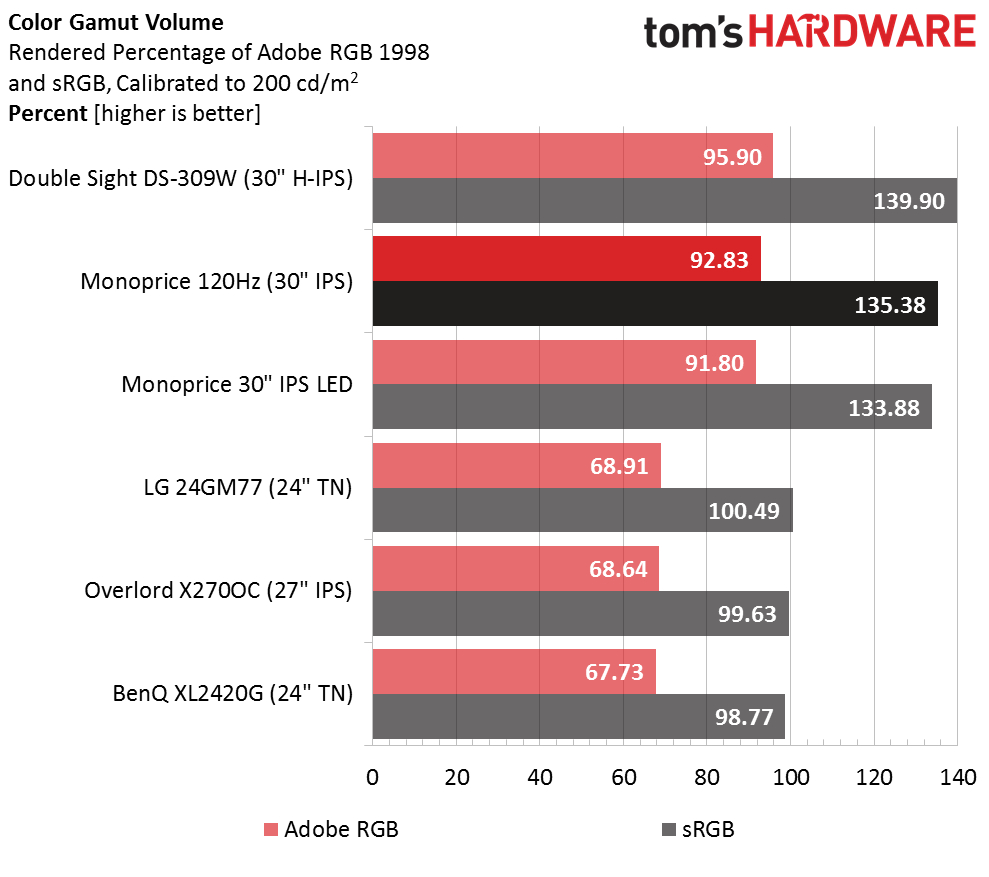Monoprice G-Pro 30-Inch 120Hz IPS Gaming Monitor Review
So far we’ve only had the chance to test one 120Hz IPS monitor, Overlord’s X270OC. Now Monoprice has brought its G-Pro 120Hz 30-inch 16:10 screen to the fast IPS party. Today we see how it performs in our benchmark suite.
Why you can trust Tom's Hardware
Results: Color Gamut And Performance
For details on our color gamut testing and volume calculations, please click here.
After our experience with Monoprice’s other 30-inch display, we wondered if the G-Pro was wide-gamut as well. As you can see by the first chart, it is. The sRGB/Rec.709 gamut represented above is quite a bit smaller than Adobe RGB.
What does this mean to you? Gaming and movie content is almost exclusively mastered using sRGB/Rec.709. When you view that content on a wide-gamut screen, its color looks over-saturated and, in some cases, unnatural. Whether or not you like this is a matter of personal preference; it's just not our preference.
When you compare the measurements to an Adobe RGB gamut, the results are closer to correct. However, red, magenta and blue are still over-saturated. If you look at the luminance chart in the middle, those colors are dialed down in brightness to compensate. Consequently, the overall errors are small.
Now we return to the comparison group:
Thanks to decent engineering, the overall color gamut error is pretty low. Dropping the luminance values for red, magenta and blue brings the DeltaE numbers to a good level. While we wouldn’t choose the G-Pro for color-critical work, it is a decent wide-gamut option when precision isn’t your top priority.
Gamut Volume: Adobe RGB 1998 And sRGB
You’d think that the Adobe RGB gamut volume would be higher given the over-saturation we measured. But there are slight deficiencies in green and cyan that reduce the number. If you like bright vibrant color, this display delivers. To the critical eye it will look a bit unnatural at times, though most enthusiasts will still be satisfied by it.
Get Tom's Hardware's best news and in-depth reviews, straight to your inbox.
Current page: Results: Color Gamut And Performance
Prev Page Results: Grayscale Tracking And Gamma Response Next Page Results: Viewing Angles, Uniformity, Response And Lag
Christian Eberle is a Contributing Editor for Tom's Hardware US. He's a veteran reviewer of A/V equipment, specializing in monitors. Christian began his obsession with tech when he built his first PC in 1991, a 286 running DOS 3.0 at a blazing 12MHz. In 2006, he undertook training from the Imaging Science Foundation in video calibration and testing and thus started a passion for precise imaging that persists to this day. He is also a professional musician with a degree from the New England Conservatory as a classical bassoonist which he used to good effect as a performer with the West Point Army Band from 1987 to 2013. He enjoys watching movies and listening to high-end audio in his custom-built home theater and can be seen riding trails near his home on a race-ready ICE VTX recumbent trike. Christian enjoys the endless summer in Florida where he lives with his wife and Chihuahua and plays with orchestras around the state.
-
kyuuketsuki Generally a Monoprice fan, but the frame-skipping makes this monitor pretty unappealing for its intended market. Hopefully they can fix it with a firmware update.Reply -
blackmagnum Monoprice is such a cheap-skate name. Why not chose a brandname less price concious like Lemon or something?Reply -
MonsterCookie I think this FINALLY is a step in the RIGHT direction. Sadly you cannot buy this in Europe.Reply
I was long ago looking for a 2560x1600 screen, and I got a Dell second-hand, because for whatever reason manufacturers ignore the customers, and they
stick to 1080p. No offense to anybody who plays at 1080p, but you need to understand, that most people do productivity and game when they have too much free time, and they want to immerse into the game on a large screen.
Personally I still love older games (Wolfenstein, FC1, Half-Life etc.) more than newer releases, and those run on these resolutions at any half-decent video card.
Furthermore, nowadays even a 500Euro *MOBILE PHONE* can do above 1080p resolution on a tiny 6" screen, and for that money they give you 32-64GB of flash, 1GB of RAM and a quad-core CPU in a tiny box.
Thus, I do not buy into this 1080p-1440p crap screen manufacturers are trying to shovel down at our throats for 1000Euros. -
danlw At this point, I think an IPS gaming monitor is like SATAe... A technology that can be skipped because something better exists. Give me an OLED gaming monitor. LG makes a 55" 1080p OLED TV for $2000... why not a 24"-ish OLED monitor for under $1000? You'd have a ginormous color gamut, infinite contrast, true black, and response times <1ms. It's time for somebody to come out with an OLED monitor that doesn't cost $5500! (Sony PVMA250)Reply -
MasterMace I'm more of the type of consumer that likes products to work as advertised out of the box - i.e. 120hz IPS 1080p out of the box. I don't want to have to "overclock" it to its advertized settings, and then have it not work on the advertised ports.Reply
Any overclocking I do personally shouldn't be advertised on the box. -
toddybody Cool Specs, and I really dig the larger panel sizeReply
...that said, after using G-Sync for 6 months now I'm scratching my head as to why any manufacturer would make a gaming panel without G-Sync or Free Sync in it.
Refresh induced stuttering and frame tearing shouldn't be acceptable in 2015 -
soldier44 Been gaming on a HP 30 inch IPS now for 5 years at 60hz. Its been worth every penny for $1200. I would steer clear of this off brand monitor regardless of 120 hz.Reply -
Eggz Close, but no cigar, MonoPrice. Looks like the Acer Predator XB270HU stays on top for now.Reply



